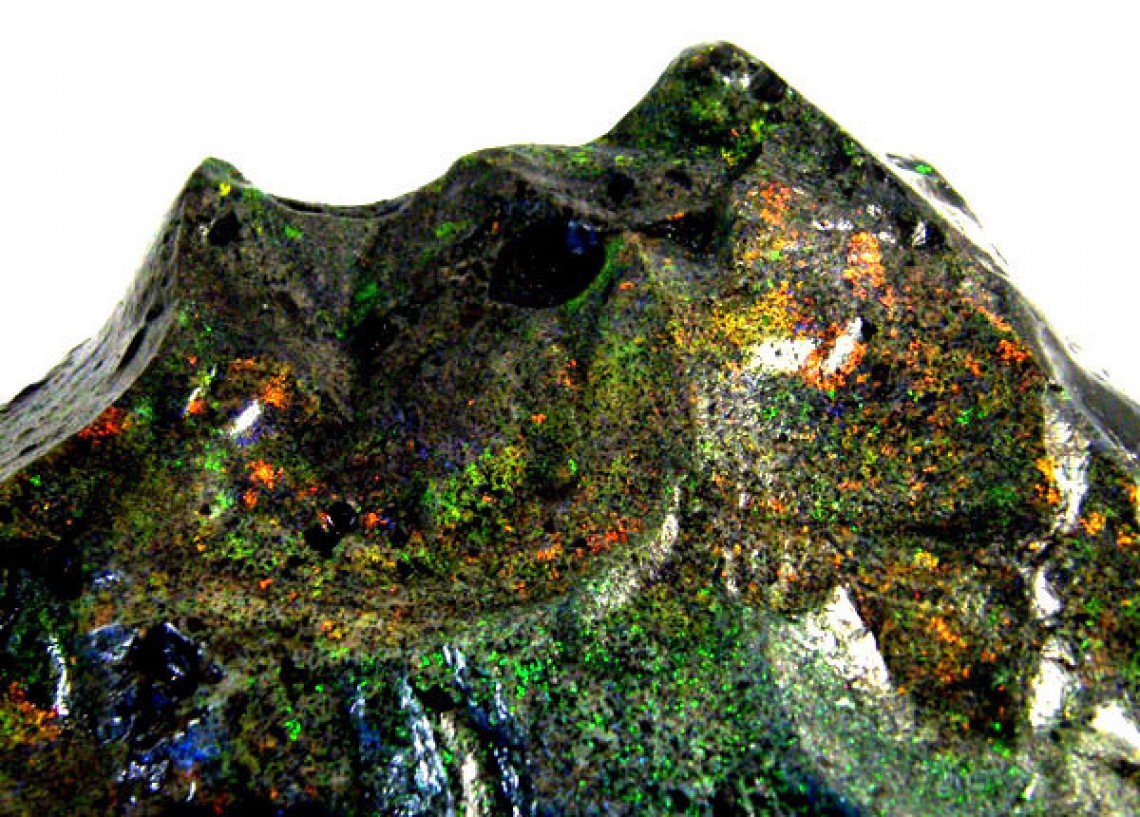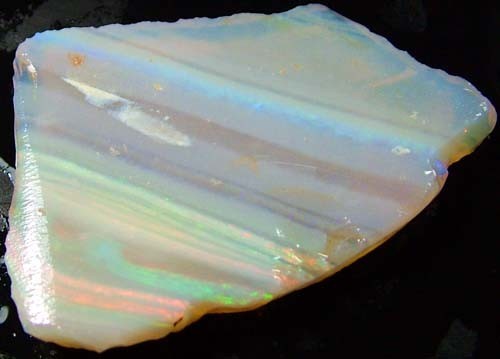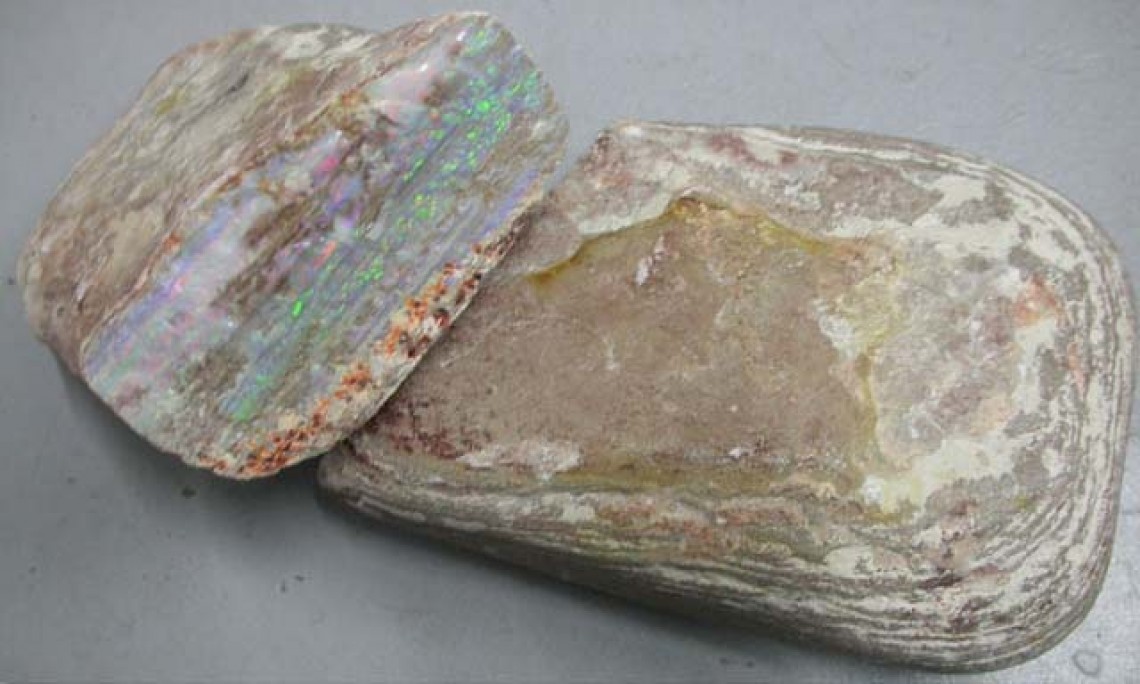
Historia del ópalo de Andamooka y cómo tratarlo

[Tiempo de lectura: 10 minutos]
En Australia Meridional, el ópalo se descubrió por primera vez en Andamooka durante la década de 1930. El primer yacimiento de ópalo de Andamooka fue descubierto por Sam Brookes y Roy Sheppard. Sorprendidos por una tormenta, se refugiaron bajo un árbol cuando una hermosa piedra les llamó la atención. Posteriormente, se descubrieron depósitos más pequeños, como Lambina en 1930 y Stuart Creek en 1947. El ópalo de Andamooka se encuentra en la delgada lutita marina «Bulldog Shale», que constituye una parte importante del subgrupo Marree del período Cretácico Inferior.
Resumen
Andamooka es uno de los yacimientos de ópalo más antiguos conocidos de Australia.
Los ópalos de Andamooka se han utilizado en la joyería de la Reina.
El ópalo de Andomooka se puede tratar con azúcar para volverlo negro y mejorar su juego de colores.

Ópalo Andamooka famoso
El ópalo de Andamooka, también conocido como el «Ópalo de la Reina», fue tallado y engastado en un collar de paladio de 18 quilates en 1954. Fue obsequiado a la reina Isabel II con motivo de su primer viaje oficial a Australia. Actualmente, el collar y los pendientes se consideran una parte importante de las joyas de la corona de la reina Isabel II. El ópalo final pesó 203 quilates.

Descubierto en 1930, Andamooka se considera uno de los yacimientos de ópalo más importantes de Australia. Ha producido algunas de las piezas y conjuntos de ópalo más atractivos, como el Ópalo Matriz de Andamooka, también conocido como el Ópalo de la Reina. El nombre Andamooka proviene de una palabra aborigen que significa «Gran Pozo de Agua». Se encuentra a 600 kilómetros al norte de Adelaida y es la única ciudad australiana donde ninguna de sus calles tiene nombre.

Tratamiento de ópalo de Andamooka
Las minas de ópalo de Andamooka son bien conocidas por producir ópalo claro, que es una variedad de ópalo blanco cristalino, a veces denominado ópalo “leche”.
El ópalo matriz es un ópalo permeable originario de Andamooka, Australia Meridional. En Andamooka también se encuentra una variedad de ópalo de roca . La mayor parte de la roca circundante es cuarcita, por lo que a veces el ópalo se forma entre esta roca tan dura. A estos ópalos se les conoce como las «damas pintadas».

El ópalo matriz de Andamooka se somete regularmente a un tratamiento para mejorar su color mediante la creación de un cuerpo negro con carbón negro. Este tratamiento consiste en un proceso químico que se aplica a toda la piedra. Al extraerlo de la tierra, puede tener un aspecto bastante pastoso, pero al tratarlo con un tinte de carbono, adquiere un aspecto mucho más atractivo.
Una vez tratado por completo, se conoce como ópalo matriz tratado de Andamooka. El tratamiento consiste en una solución rica de azúcar y agua, seguida generalmente de una fase de cocción a fuego lento en un baño de ácido sulfúrico concentrado. Los azúcares penetran en la matriz de piedra caliza, y luego el ácido la cuece, transformando el azúcar blanco que rodea las vetas de ópalo en un carbono negro. El resultado es que la matriz oscurecida envuelve las vetas de ópalo, que no difractan la luz. Algunos mineros sustrajeron los ópalos originales y los vendieron en el extranjero como ópalo negro de Lightning Ridge. Tras descubrirse el fraude, hubo una época en la que nadie compraba ópalo matriz tratado. Sin embargo, los extraordinarios colores y la rica matriz negra de las mejores gemas son precisamente los atributos que hacen famoso al ópalo negro de Lightning Ridge. El tratamiento de estas piedras de matriz implica un método de procesamiento relativamente sencillo.
 A veces se utiliza una resina epoxi de vidrio para dar a las piedras un brillo precioso. Puedes encontrarla aquí .
A veces se utiliza una resina epoxi de vidrio para dar a las piedras un brillo precioso. Puedes encontrarla aquí .

Huesos de dinosaurio de Andamooka
En Andamooka se han encontrado fósiles y huesos de dinosaurios, muchos de los cuales se exhiben en museos. Los dinosaurios australianos tienen entre 100 y 240 millones de años, lo que los sitúa en los períodos Jurásico y Cretácico. Si bien existen huesos de dinosaurios en muchos países, solo en Australia se han encontrado fósiles de dinosaurios opalizados.
Precio del ópalo de Andamooka
El ópalo matriz puede tener un precio bastante razonable, a diferencia del ópalo negro auténtico. Es importante que los compradores consulten con un vendedor de ópalos para asegurarse de que están adquiriendo un ópalo negro auténtico o un ópalo matriz de Andamooka . 
Cómo tratar el ópalo matriz de Andamooka
El equipo utilizado es muy básico. Para calentarlo, use una sartén eléctrica vieja con termostato. Es muy importante no sobrecalentar el ópalo, ya que puede fracturarse si se calienta demasiado.
Coloque una mezcla de 1 taza de azúcar (blanca o morena no parece hacer ninguna diferencia) en un recipiente Pyrex u otro recipiente resistente al calor con una cantidad equivalente de agua y caliente hasta que el azúcar se disuelva.
Para calentar la sartén, colóquela a fuego medio. El recipiente de Pyrex puede colocarse directamente sobre la sartén.
Antes de tratar el ópalo matriz, es necesario cortarlo, darle forma y lijarlo, pero no pulirlo. El ópalo debe secarse completamente mediante un calentamiento suave para eliminar la humedad de sus poros. Evite tocar la piedra con los dedos, ya que la grasa de estos puede afectar el tratamiento.
La piedra o piedras se colocan en la solución de almíbar y se cuecen durante al menos 8 horas. El tiempo de cocción es aproximado y depende de la porosidad de las piedras. Una matriz muy porosa absorberá la solución de azúcar mucho más rápido que una matriz densa. No sé cómo calcular cuánto tiempo tardará, pero 8 horas parece un buen punto de partida.
Tras la cocción, déjelas enfriar. Si la solución de azúcar se espesa demasiado debido a la evaporación durante la cocción, puede ser necesario añadir un poco más de agua.
La siguiente etapa es muy peligrosa, ya que implica el uso de ácido sulfúrico altamente concentrado. Este es muy corrosivo y los vapores también pueden ser peligrosos.
Utilice ácido sulfúrico al 93% obtenido de un proveedor de productos químicos.
Coloca una pequeña cantidad en un recipiente de Pyrex y ponlo en la sartén. La sartén está en un cobertizo bien ventilado.
Al verter el ácido en el recipiente, se recomienda usar guantes de goma y protección ocular, ya que el ácido produce quemaduras graves si salpica la piel; por lo tanto, tenga mucho cuidado. Además, nunca vierta el ácido en agua, ya que reaccionará violentamente y podría salpicarle. Preferiblemente, use también una mascarilla.
Las piedras se retiran con cuidado de la solución de azúcar con pinzas de plástico (no metálicas, ya que reaccionan con el ácido) y se colocan con delicadeza en el ácido después de dejar escurrir el exceso de solución de azúcar. No se deben limpiar las piedras en este paso. Luego, se cocinan en el ácido tibio durante al menos dos horas. En este punto, habrán cambiado de color. Se retiran con cuidado con pinzas de plástico y se colocan en otro recipiente con una solución de azúcar diluida o una solución de bicarbonato de sodio para neutralizar el ácido.
Tras unos minutos, se pueden admirar, aunque aún falta el pulido final. Mientras estén húmedas, se apreciará la asombrosa transformación que ha tenido lugar. Los colores del ópalo se mostrarán con toda claridad.
Si la matriz era bastante densa, ahora debería poder pulir la piedra. Es mejor no usar óxido de cerio ni óxido de estaño, ya que el compuesto de pulido puede penetrar en los poros y dejar pequeñas manchas blancas que pueden dañar la superficie. Para el pulido, utilice una almohadilla de cuero con diamante de grano 50.000.
Es necesario tener mucho cuidado de no aplicar demasiada presión, ya que esto generará mucho calor y podría agrietar la piedra. La matriz más porosa podría no pulirse en absoluto. En ese caso, la superficie se puede recubrir con vidrio líquido para obtener un acabado de alto brillo. Hablaré de este tratamiento en otra publicación.
No olvides desechar el ácido con cuidado. Añádelo al agua muy lentamente y entiérralo en el jardín cuando esté muy diluido. No añadas agua al ácido, ya que salpicará y podría quemarte. Si te salpica, lava bien la zona afectada con agua. Si alguien tiene algún comentario sobre este tratamiento o sobre tratamientos alternativos, por favor, compártelo. Este proceso me ha funcionado y he conseguido unas piedras preciosas que se parecen mucho a ópalos negros de calidad y me han costado muy poco.
Compra ópalos de Andamooka
Buscar en el Opal Encyclopedia
Subastas relacionadas
Artículos relacionados
El ópalo de roca es uno de los ópalos más valiosos y subestimados del mercado. Descubra más sobre este ópalo único y explore las hermosas piedras que tenemos a la venta.
29th May 2019
Todos los poemas de esta página pertenecen a sus respectivos autores. Se prohíbe su reproducción no autorizada.
9th May 2018
últimos artículos
Los ópalos negros son la variedad más codiciada, con bases profundas que crean un arcoíris de reflejos en la parte superior. ¡Descubre los usos, las propiedades, la historia y el valor de los ópalos negros!
7th Dec 2025
Descubra cómo se clasifican los ópalos y qué factores influyen en su precio. Desde el color y el brillo hasta la talla y el origen, aprenda cómo se valora cada tipo de ópalo, con ejemplos de rangos de precios.
19th Jul 2023
¡Acompáñanos en un viaje y descubre el poder curativo de los ópalos de la mano de nuestra escritora invitada Vivien Schapera, de Crystal Healing Techniques!
20th May 2023
Categorías de artículos
All there is to know about Opals including Black Opals, Ethiopian Opals & Boulder Opal
14 Artículos
Check out our fascinating information and articles on all things amazing in the Opal world
41 Artículos
Opal Auctions sellers who are approved as opal Verified Sellers
4 Artículos




![60.35 CTS ANDAMOOKA MATRIX OPAL RED ORANGE FIRE[SEDA7622]](https://liveplatforms-production.b-cdn.net/tenants/oa/uploads/images/930000-934999/930083/5f5080a8e458f.jpg?width=480&aspect_ratio=1001%3A1000)
![37.55 CTS ANDAMOOKA MATRIX OPAL RED ORANGE FIRE[SEDA7620]](https://liveplatforms-production.b-cdn.net/tenants/oa/uploads/images/930000-934999/930030/5f5080b273efa.jpg?width=480&aspect_ratio=1001%3A1000)
![40.20 CTS ANDAMOOKA MATRIX OPAL RED ORANGE FIRE[SEDA7618]](https://liveplatforms-production.b-cdn.net/tenants/oa/uploads/images/930000-934999/930027/5f5080bcef2fa.jpg?width=480&aspect_ratio=1001%3A1000)
![35.00 CTS ANDAMOOKA MATRIX OPAL RED ORANGE FIRE[SEDA7617]](https://liveplatforms-production.b-cdn.net/tenants/oa/uploads/images/930000-934999/930026/5f5080c13006b.jpg?width=480&aspect_ratio=1001%3A1000)